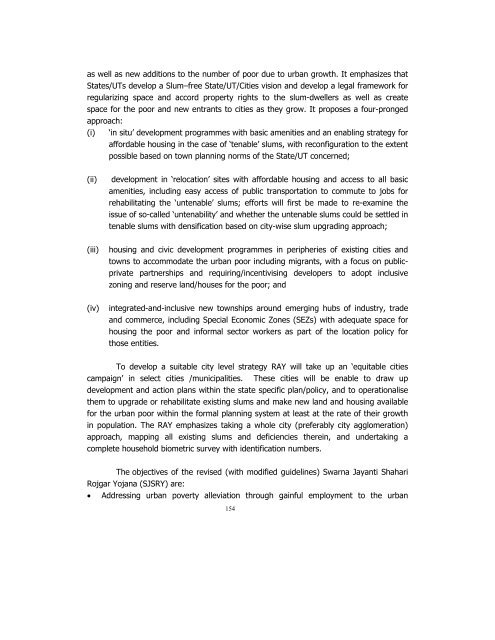POVERTY REDUCTION STRATEGY TN
You also want an ePaper? Increase the reach of your titles
YUMPU automatically turns print PDFs into web optimized ePapers that Google loves.
as well as new additions to the number of poor due to urban growth. It emphasizes that<br />
States/UTs develop a Slum–free State/UT/Cities vision and develop a legal framework for<br />
regularizing space and accord property rights to the slum-dwellers as well as create<br />
space for the poor and new entrants to cities as they grow. It proposes a four-pronged<br />
approach:<br />
(i) ‘in situ’ development programmes with basic amenities and an enabling strategy for<br />
affordable housing in the case of ‘tenable’ slums, with reconfiguration to the extent<br />
possible based on town planning norms of the State/UT concerned;<br />
(ii)<br />
(iii)<br />
(iv)<br />
development in ‘relocation’ sites with affordable housing and access to all basic<br />
amenities, including easy access of public transportation to commute to jobs for<br />
rehabilitating the ‘untenable’ slums; efforts will first be made to re-examine the<br />
issue of so-called ‘untenability’ and whether the untenable slums could be settled in<br />
tenable slums with densification based on city-wise slum upgrading approach;<br />
housing and civic development programmes in peripheries of existing cities and<br />
towns to accommodate the urban poor including migrants, with a focus on publicprivate<br />
partnerships and requiring/incentivising developers to adopt inclusive<br />
zoning and reserve land/houses for the poor; and<br />
integrated-and-inclusive new townships around emerging hubs of industry, trade<br />
and commerce, including Special Economic Zones (SEZs) with adequate space for<br />
housing the poor and informal sector workers as part of the location policy for<br />
those entities.<br />
To develop a suitable city level strategy RAY will take up an ‘equitable cities<br />
campaign’ in select cities /municipalities. These cities will be enable to draw up<br />
development and action plans within the state specific plan/policy, and to operationalise<br />
them to upgrade or rehabilitate existing slums and make new land and housing available<br />
for the urban poor within the formal planning system at least at the rate of their growth<br />
in population. The RAY emphasizes taking a whole city (preferably city agglomeration)<br />
approach, mapping all existing slums and deficiencies therein, and undertaking a<br />
complete household biometric survey with identification numbers.<br />
The objectives of the revised (with modified guidelines) Swarna Jayanti Shahari<br />
Rojgar Yojana (SJSRY) are:<br />
• Addressing urban poverty alleviation through gainful employment to the urban<br />
154

















